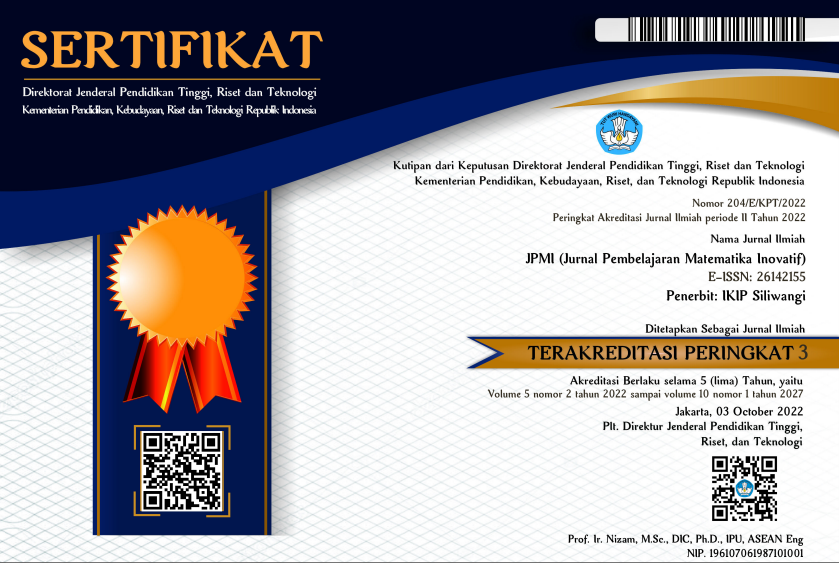Framework VueJS sebagai media bantuan problem based learning terhadap kemampuan pemecahan masalah matematis siswa SMP kelas VIII
DOI:
https://doi.org/10.22460/jpmi.v7i6.24923Keywords:
Problem Based Learning, VueJS, Probability.Abstract
This study aims to determine the differences in mathematical problem-solving abilities between learning with Problem Based Learning assisted by VueJS and not. The research method used is quantitative quasi-experimental. The sample population of this study were two groups of grade VIII junior high school students who had not received probability material as the control class and the experimental class. The instrument used was a test instrument in the form of descriptive questions to measure mathematical problem-solving abilities. Quantitative data obtained from the control class and the experimental class after the learning was completed. The results showed that the post-test data for the experimental class were not normally distributed while the control class was normally distributed. The Mann-Whitney test was carried out and gave a value greater than the probability value. Therefore, it can be concluded that learning with the Problem Based Learning model assisted by VueJS does not provide a significant difference either with the treatment given or not.
References
Angela, F., & Kartini, K. (2021). Analisis kesalahan dalam menyelesaikan soal matematika materi peluang empirik dan teoretik pada siswa kelas VIII SMP di Kabupaten Siak. AXIOM : Jurnal Pendidikan Dan Matematika, 10(1), 15–25. https://doi.org/10.30821/AXIOM.V10I1.7692
Anggiana, A. D. (2019). Implementasi model problem based learning (PBL) untuk meningkatkan kemampuan pemecahan masalah matematis siswa. Symmetry: Pasundan Journal of Research in Mathematics Learning and Education, 4(2), 56–69. https://doi.org/10.23969/SYMMETRY.V4I2.2061
Aprianti, B. D., Sucipto, L., & Kurniawati, K. R. A. (2020). Analisis kemampuan pemecahan masalah matematika kelas VIII berdasarkan gaya belajar siswa. Paedagoria : Jurnal Kajian, Penelitian Dan Pengembangan Kependidikan, 11(3), 289–296. https://doi.org/10.31764/PAEDAGORIA.V11I3.2662
Aulia, L. N., Susilo, S., & Subali, B. (2019). Upaya peningkatan kemandirian belajar siswa dengan model problem-based learning berbantuan media Edmodo. Jurnal Inovasi Pendidikan IPA, 5(1), 69–78. https://doi.org/10.21831/JIPI.V5I1.18707
Dewi, P. S., & Septa, H. W. (2019). Peningkatan kemampuan pemecahan masalah dan disposisi matematis siswa dengan pembelajaran berbasis masalah. MATHEMA: JURNAL PENDIDIKAN MATEMATIKA, 1(1), 31–39. https://ejurnal.teknokrat.ac.id/index.php/jurnalmathema/article/view/352
Fauzy, A., & Nurfauziah, P. (2021). Kesulitan pembelajaran daring matematika pada masa pandemi covid-19 di SMP muslimin cililin. Jurnal Cendekia : Jurnal Pendidikan Matematika, 5(1), 551–561. https://doi.org/10.31004/CENDEKIA.V5I1.514
Gumanti, G., Maimunah, M., & Roza, Y. (2022). Kemampuan pemecahan masalah matematis siswa SMP Kecamatan Bantan. PRISMA, 11(2), 310–319. https://doi.org/10.35194/JP.V11I2.2301
Gunawan, I., Amalia, R., Syaban, M., & Nurhayati, L. (2022). Pengaruh model problem based learning terhadap peningkatan kemampuan pemecahan masalah matematis siswa (studi meta-analisis). Jurnal Pendidik Indonesia, 3(2), 214–223. https://doi.org/10.61291/JPI.V3I2.8
Hermawindiana, A., Murni, A., & Roza, Y. (2024). Penerapan model problem based learning pada kurikulum merdeka untuk meningkatkan kemampuan pemecahan masalah matematis materi peluang. Pi: Mathematics Education Journal, 7(1), 12–21. https://doi.org/10.21067/PMEJ.V7I1.9598
Hidayatullah, L. S. (2023). Pembangunan media materi pembelajaran untuk pembelajaran mandiri pada jenjang sma berbasis website menggunakan framework laravel (studi kasus : SMA Negeri 1 Mempawah Hulu). http:/www.teknik.unpas.ac.id
Kedah, Z. (2023). Inovasi penerapan teknik gamifikasi terhadap pembelajaran kampus merdeka. Jurnal MENTARI: Manajemen, Pendidikan Dan Teknologi Informasi, 1(2), 133–143. https://doi.org/10.33050/MENTARI.V1I2.259
Laila, H. T., & Harefa, D. (2021). Hubungan kemampuan pemecahan masalah matematis dengan kemampuan komunikasi matematik siswa. Aksara: Jurnal Ilmu Pendidikan Nonformal, 7(2), 463–474. https://doi.org/10.37905/AKSARA.7.2.463-474.2021
Lesi, A. N., & Nuraeni, R. (2021). Perbedaan kemampuan pemecahan masalah matematis dan self-confidence siswa antara model TPS dan PBL. Plusminus: Jurnal Pendidikan Matematika, 1(2), 249–262. https://doi.org/10.31980/PLUSMINUS.V1I2.899
Mulyadi, K., & Ratnaningsih, N. (2022). Analisis pencapaian dan kendala penerapan problem based learning pada pembelajaran tatap muka terbatas (PTMT). J-KIP (Jurnal Keguruan Dan Ilmu Pendidikan), 3(1), 37–46. https://doi.org/10.25157/J-KIP.V3I1.7023
Rambe, A. Y. F., & Afri, L. D. (2020). Analisis kemampuan pemecahan masalah matematis siswa dalam menyelesaikan soal materi barisan dan deret. AXIOM : Jurnal Pendidikan Dan Matematika, 9(2), 175–187. https://doi.org/10.30821/AXIOM.V9I2.8069
Rasyada, R. (2023). Implementasi problem based learning (PBL) pada mata pelajaran matematika. BASICA Journal of Arts and Science in Primary Education, 3(1), 151–162. https://doi.org/10.37680/BASICA.V3I1.3943
Suputra, K. Y., Sujana, I. W., & Darmawati, I. G. A. P. S. (2021). Penerapan model problem based learning berbantuan geogebra meningkatkan hasil belajar matematika. Journal of Education Action Research, 5(3), 423–431. https://doi.org/10.23887/JEAR.V5I3.36898
Wahida, F., & Andriyani. (2022). Keefektifan model model problem based learning dalam meningkatkan kemampuan koneksi matematis dan keaktifan belajar materi peluang. Formosa Journal of Sustainable Research, 1(2), 97–116. https://doi.org/10.55927/FJSR.V1I2.711
Yuhani, A., Zanthy, L. S., & Hendriana, H. (2018). Pengaruh pembelajaran berbasis masalah terhadap kemampuan pemecahan masalah matematis siswa SMP. JPMI (Jurnal Pembelajaran Matematika Inovatif), 1(3), 445–452. https://doi.org/10.22460/JPMI.V1I3.P445-452
Downloads
Published
Issue
Section
License

This work is licensed under a Creative Commons Attribution-ShareAlike 4.0 International License.
The author is responsible for acquiring the permission(s) to reproduce any copyrighted figures, tables, data, or text that are being used in the submitted paper. Authors should note that text quotations of more than 250 words from a published or copyrighted work will require grant of permission from the original publisher to reprint. The written permission letter(s) must be submitted together with the manuscript.
















